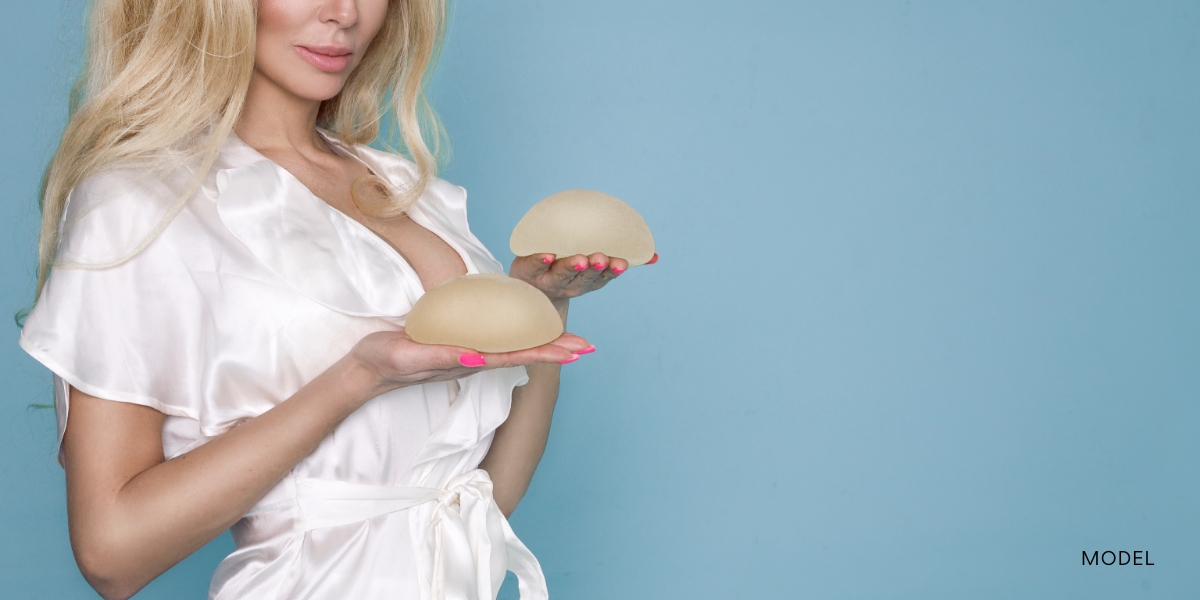 Some women are perfectly content with the size and shape of their breasts… and if that is you, then great! If you are reading this, though, it is probably because you have some reservations about your own figure. Maybe the breasts you were born with simply are not as large as you would like. Or maybe, whether due to pregnancy, breastfeeding, or major fluctuations in body weight, you have lost some breast volume. If for any reason, you are unhappy with the dimensions of your breasts, that might make you a good candidate for breast implants.
Some women are perfectly content with the size and shape of their breasts… and if that is you, then great! If you are reading this, though, it is probably because you have some reservations about your own figure. Maybe the breasts you were born with simply are not as large as you would like. Or maybe, whether due to pregnancy, breastfeeding, or major fluctuations in body weight, you have lost some breast volume. If for any reason, you are unhappy with the dimensions of your breasts, that might make you a good candidate for breast implants.
Before scheduling a breast augmentation procedure, it is important to understand exactly what the process entails. For one thing, breast implants are not all created equal. You will need to make some crucial decisions about the type of breast implants you desire, which may impact cost, incision size, the quality of your results, and the longevity of your results.
In this guide, we will walk you through everything you need to know about breast implants.
Are You a Good Candidate for Breast Implants?
Before you start shopping for implants, take a moment to pause and conduct a quick self-inventory. Are you really a good candidate for a safe, effective breast augmentation procedure? And will getting breast implants truly help you achieve your aesthetic goals? Dr. Sanders would love to sit down with you for a one-on-one consultation, helping you determine your answers to these critical questions.
Generally speaking, the best candidates for breast implants are women who fall into the following categories:
- You are in good physical health overall. You do not have any untreated issues, you do not have any active infections, and you do not have untreated cancer. If you do have any such underlying issues, it is imperative to share them with your surgeon, who will want a full medical history to ensure your safety during the operation.
- You are unhappy with the volume of your breasts. You feel as though your breasts are too small, flattened, asymmetrical, or simply lacking in sufficient cleavage.
- You do not smoke. Nicotine can impact your ability to heal, and may place you into a higher surgical risk category.
- You are in a healthy frame of mind, and have realistic expectations. Getting breast implants can lead to permanent changes to your physical appearance. It is not a decision to make lightly, nor without first having a proper consultation with a qualified plastic surgeon.
- You understand the risks. While breast augmentation is very common, and breast implants are FDA-approved, any surgery carries some risk. Make sure you have thoroughly discussed the risks with your plastic surgeon.
- You are seeking breast implants because they will make you happy. Getting implants to improve your own self-image or self-confidence is one thing. Getting implants because someone else wants you to is a bad idea, and something to be cautioned against.
If you fit the criteria above, then you may be an excellent candidate to receive breast implants. Now comes the next question: What kind of implants are right for you?
Choosing the Right Breast Implant Material
There are a number of factors to account for when choosing breast implants, including the implant material, profile, and incision site. Naturally, the best way to make these decisions is in collaboration with your surgeon. Before your consultation, however, it may be smart to study up on the basics.
To begin with, let us examine some of the different materials used to make breast implants. There are four basic options: Saline implants, silicone implants, structured implants, and what are known as “gummy bear” implants. Consider some of the pros and cons of each option.
Saline Implants
Saline breast implants are filled with sterilized salt water. A major advantage is that should these implants rupture for any reason, the salt water is simply absorbed into your body and expelled as natural waste.
Saline implants have been around since the 1960s, and they are FDA-approved for women ages 18 and up.
However, saline implants are not without their drawbacks. Some women report that their saline implants give the very slight sensation of sloshing water. Others report that saline implants are the ones most visible beneath the skin, often contributing to a “rippling” effect. Finally, note that some women find saline implants to have a firmer feel than natural breast tissue.
Silicone Implants
Breast implants can also be made out of silicone, a synthetic material that has a very similar feel and texture to human fat. Specifically, these implants are made of a silicone case that is then filled with silicone gel.
The greatest advantage to choosing silicone implants is that they tend to have a much more natural feel to them. Patients who get silicone implants are encouraged to have MRIs every few years to check for potential ruptures.
Silicone implants are generally approved for women age 22 and older. However, there may be some exceptions made for younger women, specifically those who need implants for breast reconstruction.
Structured Implants
One of the more recent advances in breast implant technology is the development of structured implants, also called structured saline implants. These are basically conventional saline implants with one significant distinction: The inside of the implant is structured with a much more natural feel and appearance. In other words, you can get the aesthetics you want and still enjoy the peace of mind that comes from having safe, sterile saline.
It is also worth noting that, compared with other types of implants, the structured ones have a fairly low rate of rupture.
Gummy Bear Implants
Finally, we have gummy bear implants, so named because they maintain their shape and structure even if the outer shell is broken. (You know… like gummy bears!)
These implants are filled with a silicone gel that is much thicker than what you would find in traditional silicone implants. Additionally, they have a slightly firmer feel to them.
Gummy bear implants are popular, and not without reason. However, there are a couple of downsides to point out. One is that the shape of gummy bear implants is rounded at the bottom and tapered toward the top; it is possible for an implant to rotate, which will give the breast an odd shape. Surgical intervention is needed to address this issue. Additionally, gummy bear implants usually require a longer incision than other types of implants. They are also textured, and this may be associated with a rare disease called ALCL that involves a lymphoma of the scar tissue envelope.
Breast Implant Shape and Profile
Another important consideration when choosing breast implants is shape. The two basic breast implant shapes are teardrop and round. However, in addition to choosing the shape, you will also need to select the right implant profile. Basically, profile refers to the overall height of the implant.
Choosing the Right Shape for Your Breast Implants
To begin with, consider teardrop vs. round breast implants.
Teardrop Implants
Teardrop implants are sometimes just called “shaped implants,” and were initially developed for use in reconstructive surgery. The idea was to give women more options for replicating the curvature of their natural breasts. Today, teardrop implants are widely available for women seeking cosmetic breast augmentation.
The shape of these implants is oftentimes considered to be more natural-looking, which is the main reason why women choose the teardrop option. With that said, these implants also require a longer incision. And, on the off chance that the teardrop implant shifts or rotates, it can leave the breast looking rather oddly shaped. They are also textured, and this may be associated with a rare disease called ALCL that involves a lymphoma of the scar tissue envelope.
Round Implants
With round implants, of course, it does not matter whether they rotate or shift; it has no bearing on the appearance of the breasts. Round implants can be inserted with smaller incisions. And, they are generally better options for women who have hollowed out breasts at the top, and who are looking to increase upper pole fullness.
The downside? Some patients say that round implants are not quite as effective in capturing the natural look of breast tissue.
Considering Breast Implant Profile
As you choose the right shape for your breast implants, you will also want to pick the right profile. (Sometimes, this is called breast projection.)
Basically, this is a measure of how far the implant extends from your chest wall. An implant’s profile is determined by the width of its base and by how much of the base occupies the chest wall. The higher the implant profile, the narrower its base, and the more outward projection you will have.
Choosing the right profile is important, because it will have a major impact on the overall appearance of your breasts. This is a decision that you will want to make in conjunction with your plastic surgeon. As a general rule, though, you will want to pick a lower breast profile in these situations:
- You want greater fullness in the sides of your breasts (e.g., “side boobs”).
- You want more fullness in the top portion of your breasts.
- You want your breasts to be a little bit softer.
By contrast, choose a higher profile in these situations:
- You want to have pointier breasts.
- You want to have rounder breasts.
- You want your breasts to be a little bit firmer.
- You want your breasts to look more obviously “enhanced.”
Again, if you have any questions about choosing the shape or profile for your breast implants, we recommend sitting down with your plastic surgeon.
Choosing the Right Size for Your Breast Implants
Of course, one of the most consequential decisions of all is what size you choose. There are multiple considerations to bear in mind as you seek the right size for your breast implants.
The most important rule of thumb is to communicate clearly with your surgeon. On the one hand, getting your surgeon’s guidance can help alleviate any worries that you are going to come out of surgery with breasts that are still a bit too small or breasts that are too big. At the same time, clear communication with your surgeon can help put to rest any fears that your surgeon will essentially decide for you during the operation.
There are a few other tips and suggestions for patients seeking to get the right size for their breast implants:
Think About How You Want Your Breasts to Look
This may seem like an obvious point, but you should always start with a simple affirmation of your goals. For example, are you looking to reclaim the figure you had pre-pregnancy and pre-breastfeeding? Are you specifically looking to fill out your cups so that you can feel more confident during bikini season? Talk with your surgeon about your goals for breast augmentation, which can provide some direction as to the size you should aim for.
Consider Your Lifestyle
Another key point about choosing breast implants: You need to pick a breast size that fits with your lifestyle. Some questions you might ask yourself:
- Are you an athlete?
- Do you plan on having children?
- Are you currently overweight, and do you intend to lose weight?
If you like to jog or power walk in the mornings, you may wish to opt out from excessively large breasts, which may cause discomfort. If you plan on having kids, it is probably wise to avoid augmentation altogether until your childbearing days are past. And if you plan to lose weight, be aware that weight loss is likely to impact your breasts, along with the rest of your frame; again, this may be a good reason to hold off on breast augmentation for a while.
Choose Implants That Fit Your Body Type
Breast implants are never one-size-fits-all, and you will want to ensure that your surgeon understands this. For most women, the goal of breast augmentation is to get breasts that look proportional to the rest of their body, and of course, that all hinges on the body type you have. Talk with your plastic surgeon about the approach he or she will take to offer results that will bring greater harmony to your body.
Ask Your Friends
Choosing breast implants is never a decision that should be made in isolation. In addition to consulting with your plastic surgeon, you should also talk it over with friends whose opinions you trust. This might include close friends, a partner, or a spouse. They may offer helpful perspectives on the implant size that would look best on you, and help you avoid anxieties over making the wrong decision.
Think About Volume and Diameter
One more thing to think about as you contemplate getting breast implants: Size is a function of both volume and diameter, and you will want to consider both metrics as you seek the right size breast implants.
Be aware that breast implant sizes are not the same as cup sizes; you can tell your surgeon that you hope to achieve a certain cup size, and that will provide a basic sense of direction, but ultimately, implant volume is going to be measured in either cubic centimeters or in millimeters. The more cubic centimeters or millimeters, the more volume the implant has and the more it is going to project outward.
But if volume is a critical metric, so is diameter. Diameter refers to the width of the implant at its widest point. Even if two implants have the exact same volume, they may have a different shape if they have different diameters.
Additional Tips for Choosing Breast Implants
As you prepare to talk with your plastic surgeon about breast implants, there are a few more guidelines that can help you make a wise decision and to feel totally confident as you head into your breast augmentation surgery.
Ask to “Try On” as Many Implants as You Like
Your surgeon should allow you to try on some implants to see roughly what they will look like. While this will not necessarily tell you much about the texture or feel of your implants, it can help you get a basic sense of size and shape. Do not hesitate to try on as many implants as you need to in order to feel confident in your decision. Some patients try 10, 20, even 30 options before committing to one.
Think Beyond Cup Size
As mentioned above, implants are not sized in the same way that bras are; thinking in terms of cup size is, at best, an imprecise way to select your implants. And ultimately, it can be rather unhelpful, too. It is usually better to have a goal like looking and feeling your best, with breasts that are more proportional to the rest of your body. Whether or not that means taking you to a C cup is beside the point. (It is also worth mentioning that bra manufacturers all size their products differently; again, this is an imprecise way of selecting breast implants.)
Be Honest About Your Body
If you want to make certain that your new breasts look proportional to the rest of your body, that means you have to be aware about your current dimensions. This may mean taking a long look in the mirror to consider the size of your hips, your buttocks, your overall height, and more. This can give you real clarity about the breast implant size you need.
Avoid Comparisons with Others
One of the most common comments that plastic surgeons hear goes something like this: “I think I should get ___ implants, because my girlfriend has them, and they look really good on her.” Of course, the key phrase here is on her. Implants of a certain size, shape, and material may be ideal for one patient but not so ideal for the next. Avoid making these comparisons, and instead, focus on working with your surgeon to find an ideal set of implants for your body.
Bring a Friend
You do not have to attend your breast implant consultation alone. In fact, it may be advantageous to bring a close friend or relative with you. The main reason for this is that when you first start talking seriously about getting breast implants, there is a lot of information to take in all at once. It is very easy to become overwhelmed, and to forget some of the important points that your surgeon brings up. Your friend can help take notes, recall important details, and offer wise counsel as you make your breast implant decision.
Schedule Multiple Consultations
You do not have to select breast implants during that initial meeting. In fact, it may be wise to try on some different sizes, get some basic details from your plastic surgeon, then leave. Sleep on it for a few days. Absorb all of the information your surgeon presents you with. Then, make a follow-up appointment where you can try on implants again. Feel free to request a few meetings if that is what it takes for you to feel really confident and comfortable in your decision.
By keeping all of these tips in mind, you should be ready to make an informed, judicious choice about your breast augmentation procedure, and about the type of breast implants that are best for your needs.
What Happens When Breast Implants Rupture?
Another important topic for women seeking breast augmentation: What happens when your breast implants rupture?
Causes of Ruptured Implants
No matter which type of implants you get, rupturing is a possibility. For example, silicone implants have an outer shell that can potentially be torn open. And, saline implants typically come with a valve; if this valve fails, it can cause the implants to leak.
Specific factors that can cause implants to rupture include the normal aging of the implant; trauma caused by a significant accident, such as a car collision; a needle insertion, such as during a biopsy; and more. The most common cause of implant rupturing is the initial breast augmentation procedure itself; some studies have shown that more than half of all implants that rupture do so because of stray incisions made during their implantation.
What Happens When Implants Rupture?
As for the immediate effects of a ruptured implant, it largely depends on the implant material you have.
If your saline implant ruptures (or if you experience a valve failure), the saline will usually spill out very quickly. Within a few days, your breasts will appear visibly deflated, letting you know that there is a problem. The good news is that sterile saline water is absorbed into the body and should not cause any further complications.
Silicone ruptures work a little differently. Because silicone is thicker than saline water, it usually takes longer for it to leak out. You may not realize your implants have ruptured for a long time; in fact, you may not realize it at all.
Generally speaking, you will know your implants have ruptured if you see any of the following signs and symptoms:
- One of your breasts changes size and shape.
- You experience pain or swelling in your breast.
- One of your breasts undergoes a change in firmness level.
If you ever think you have had an implant rupture, make an appointment with your plastic surgeon right away. Typically, they will recommend that you have an MRI, allowing them to screen and confirm that your implant has ruptured. More often than not, your insurance will decline to pay for this, so you may need to work out a satisfactory financial arrangement with your provider.
Also note that, if you have silicone breast implants, the FDA recommends that you have an MRI screening every two or three years. This will allow you to identify ruptured implants and spilled silicone, even if you do not have any other symptoms.
Correcting Ruptured Implants
What happens if your plastic surgeon confirms that one of your breast implants has ruptured? You will need corrective surgery to have the ruptured implant removed. Often, your surgeon will also remove the capsule of scar tissues that holds the implant in place.
If you have two implants and only one of them has ruptured, your surgeon will typically recommend that you just have both implants removed anyway. And if your silicone implants have leaked, your surgeon will also remove this silicone. Note that silicone is not absorbed by the body.
Often, patients who experience ruptured implants will want to have new implants placed. Most of the time, this can all be done during the same surgery. In other words, you can have your faulty implants removed and new ones put in, all with a single surgical procedure.
Assessing the Risk of Breast Implants
In addition to rupturing, there are a few other risks associated with breast implants.
According to the American Society of Plastic Surgeons, there are a number of risks associated with the augmentation procedure itself. Some of the most common surgical risks include:
- Complications with the anesthesia
- Bleeding
- Hematoma
- Infection
- Loss of nipple sensation (usually temporary, though occasionally permanent)
- Poor scarring
- Incorrect positioning of the implant
- Formation of tight scar tissue around the breast implant
- Wrinkling over the skin
In many instances, these risks can be minimized by confirming that you work with a board-certified plastic surgeon, and by being honest about your own medical history and any underlying complications. Additionally, be sure to follow through on any guidelines your surgeon gives you to prepare for surgery.
What About Breast Cancer?
One of the most common inquiries about breast implants is this: Will getting implants increase my risk of breast cancer?
As the University of Michigan notes, there have been countless studies of this very question, and they have arrived at a fairly clear consensus: Getting implants does not increase your risk of breast cancer, nor does it delay the detection of breast cancer. Finally, if you have implants and you do get cancer, you still have the same odds of remission as any other woman.
The one exception to this is a condition known as anaplastic large cell lymphoma (ALCL), a fairly rare cancer of the immune system. The FDA believes that women who have textured breast implants experience a slightly higher risk of getting ALCL. This is a risk that patients should be aware of. With that said, ALCL is easily treatable; in fact, simply removing the implants is all it takes to remove the cancer. Women who receive early treatment and detection have an almost 100 percent remission rate.
Choosing the Breast Implants That Are Right for You
The bottom line is that breast augmentation can be a life-changer. It can help you regain your pre-pregnancy form, or simply gain the figure you have always wanted. All of this depends on finding the right surgeon, making an informed decision about your implants, and making certain you know the potential risks and complications.
As you consider getting breast implants, ensure that you have a plastic surgeon who can guide you through key decisions regarding shape, size, material, and beyond. If you are ready to talk about getting breast augmentation in the Los Angeles area, reach out to the office of Dr. George H. Sanders at your next opportunity.
We would love to see you here in our practice or schedule a consultation.






